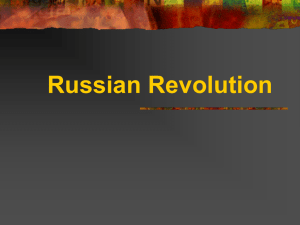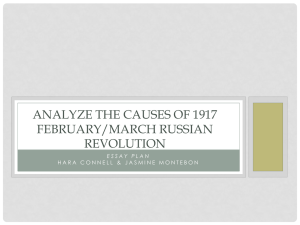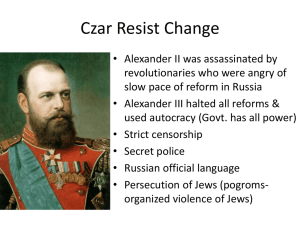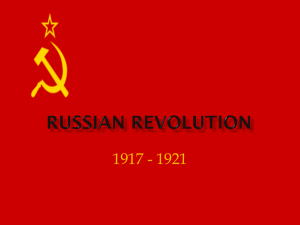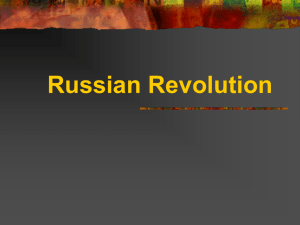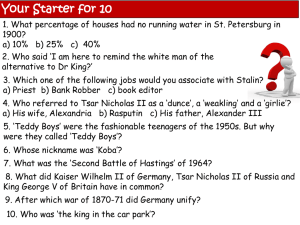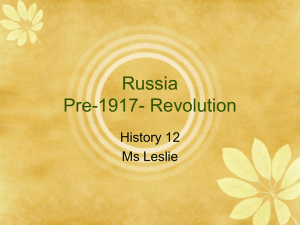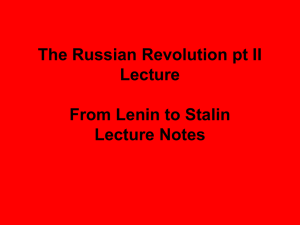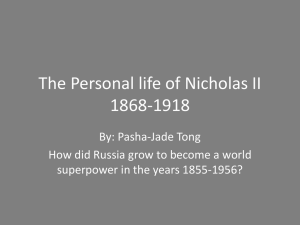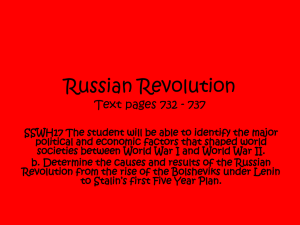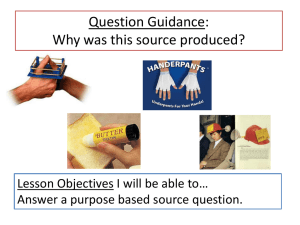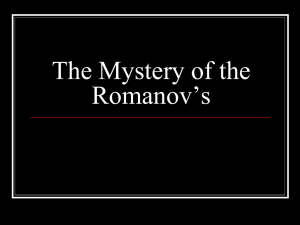The Russian Revolution
advertisement
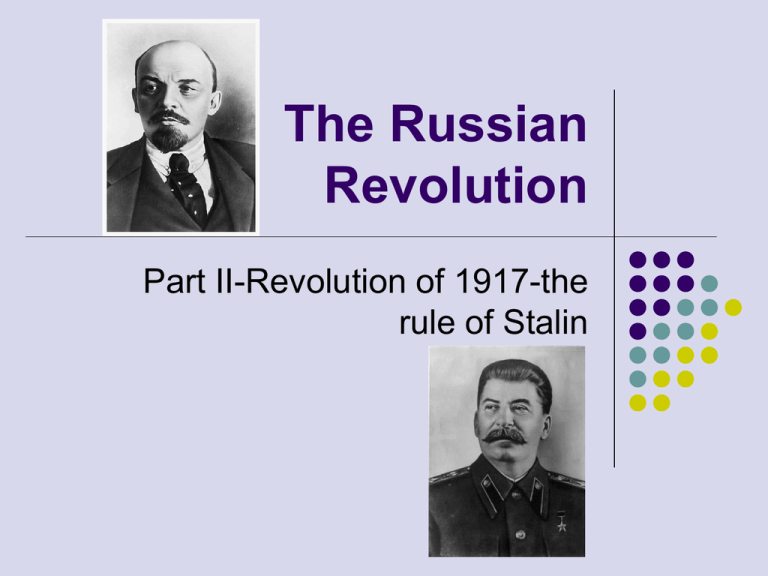
The Russian Revolution Part II-Revolution of 1917-the rule of Stalin Russia in WWI Russia felt it had to defend Serbia to protect it’s reputation in the Balkans. Russia also realized that once France was attacked, Germany would turn to Russia. Transportation of soldiers, weapons and food was slow and cumbersome by rail. Russia defeated Austrian units, but is severely defeated by Germany in East Prussia (Poland). After this defeat in July/August 1915, Nicolas II heads for the front and assumed personal command of the armed forces. The Influence of Rasputin With Nicholas gone to the front, Alexandra exerted great influence on political appointments. Alexandra did not act on her own, but sought council from her confidant Rasputin. Rasputin was a peasant healer from Siberia who had stopped the bleeding and suffering of Alexis-heir to the throne and who suffered from hemophilia. Rasputin gained influence after Nicholas left for the front. Alexandra believed that Rasputin was the “voice of the people”. Rasputin Continued…. Rasputin used his influence to take bribes and engage in questionable behavior. Nicholas did not really care for Rasputin, but tolerated him for the sake of his wife. His presence at court was considered a “family matter”. Court officials tried to bribe Rasputin to leave Petrograd, but the empress found out. The court realized there was no alternative but to assassinate him. Rasputin Cont…. On the night of Dec. 16-17, 1916 Rasputin was lured to the palace of Prince Felix Iusupov and the Tsar’s nephew, Vladimir Purishkevich. Rasputin was shot and the body weighed down with chains and thrown into a canal. The result drove Nicholas and Alexandra closer together as Nicholas felt “deeply ashamed for Russia”. The Russian Revolution After Nicholas leaves for the front, it seemed like revolution was in the air. Alexander Protopopov was the Minister of the Interior and would send soothing reports to Nicholas. Food riots and demonstrations break out in February of 1917. Nicholas demands that these be stopped by force. The Petrograd Soviet is organized in response. By February 27th, the city’s regiments were in mutiny, the red flag goes up over the Winter Palace and by nighttime, Petrograd was in the hands of uniformed peasants. The Revolution Continues The Duma vs. the Petrograd Soviet. A concession is made to the Soviets-Alexander Kerensky ( a socialist that is admitted to the government) Demand the abdication of Nicholas II comes on February 28th. This issue is what turns a local mutiny into a national revolution. Russia becomes a republic on March 17, 1917. The February Revolution was relatively bloodlessabout 170 were killed. Government after Nicholas Nicholas abdicates and is placed under house arrest. With Nicholas gone, there is a power vacuum that is not initially recognized. The Provisional Government will try to fill the void and issued countless laws intended to rectify the abuses of the old regime, but never created a set of new institutions to replace those it had destroyed. How would this power vacuum be filled? A little document analysis… Very quickly--read through The Abdication of Tsar Nicholas on your own. In your notebook O,P,V,L this document (you don’t need to do the others in the packet). Be prepared to share your results with the large group. The Bolshevik Revolution Often referred to as the October Revolution, but nothing like a revolution. October was a classic coup capture of the government by a small band of those who are well organized. Lenin returns from hiding in Finland and declares that what is needed to win over the soldiers, peasants and workers was “peace, land and bread”. By the night of Oct. 24-25 1917, armed Bolshevik’s had seized control of Petrograd. The Single Party State Lenin comes to power and establishes a regime unlike any other that had been seen. An extreme dictatorship exercised by “the party”, behind the façade of self-rule represented by the soviets. Lenin was the head of the party and by late 1918, found no opposition remaining. By March 1918, the party is renamed the Communist Party However, not everyone agreed with the new regime, the first to oppose the coup were the intelligentsia. War Communism Economic policies of the Bolsheviks between 19181921. The architects of this plan had only read socialist theories, none of them had real experience in business, let alone a nation’s economy. Nationalization of production and transportation Liquidation of private property Abolition of money as means of exchange Single plan for the entire economy Compulsory labor for all able-bodied males Red Terror Lenin began to fear that the Tsar would take part in counterrevolutionary events. Lenin decides to have the Tsar and his family assassinated. During the summer of 1918, the Romanov family was taken to Ekaterinburg. Early in the morning of July 17, the family was taken to the basement and shot. Their bodies were burned and their remains put in a shallow grave that was not discovered until 1989. Red Terror Cont…. By Dec. 1917, the Cheka is formed. This will become the major agent of terror. Terror was built into the very procedures and objectives of the Bolshevik regime. The first step in mass terror was the abolition of law. A degree in 1917 dissolved nearly all the courts abolished the legal profession. During this time, 140,000 people would be killed. “We must execute not only the guilty. Execution of the innocent will impress the masses even more”. Concentration camps were also established for political prisoners. -Discuss briefly: Why was Red Terror necessary? The Civil War 1918-1922 The Red Army was founded in 1918 and had the resources of the Tsar at its disposal. Leon Trotsky was war commissar. Civil war was the political and social struggle between the Bolshevik regime and its own citizens. Lenin welcomed civil war because true revolutionaries did not want peace. He wanted war at home and around the globe. The Civil War Cont…. The Bolsheviks labeled their military opponents as the “whites”. The whites did not fight for the restoration of the monarchy, but for a representative assembly. The White Army had few resources, most gained through the Allies, Great Britain in particular. The Red Army had nearly 3 million men, while the White Army never reached more than 250,000. There were also the “greens” (peasants), “blacks” (anarchists). Civil War Cont…. There were no real front lines, they were very fluid. Armies were randomly scattered and would attack and then retreat. Maps of the war have red, white, black and green lines running across the map. The White Army had no government to recruit troops and the different factions within could not unite. The Red Army on the other hand was lead very solidly by Leon Trotsky. While many states declared their independence and Russia lost territory, it didn’t matter because the communist regime had survived. After the Revolution, Coup and Civil War 1924, The Soviet of Socialist Republics is declared. Lenin always fearful of death, dies in 1924 at the age of 54 due to a stroke. Petrograd is renamed Leningrad in his honor. The struggle for power begins between Stalin and Trotsky. Trotsky still believes in permanent revolution, but fails to carry the rest of the party with him. Stalin has him exiled to Siberia then out of Russia. Trotsky continues to write anti-Stalinist materials and is murdered in Mexico in 1940. Stalin in Power In 1928, Stalin launched the First 5-Year Plan. The goal was rapid industrialization and collectivization of agriculture. The First 5-Year Plan was declared a success in 1932 and a Second 5-Year Plan was established lasting until 1937. A Third 5-Year Plan was interrupted by WWII. Collectivization lead to the slaughter of animals by farmers that no longer cared for things that were not theirs. This lead to widespread famine. Stalin’s Purges Stalin put many new policies in place, and open disagreement with the policies was not possible. In 1934, a friend and supporter of Stalin’s was assassinated. Stalin took this as an opportunity to strike out against his opponents. The “Old Bolsheviks” were brought to trial. Most were put to death for participating in counterrevolutionary activities and crimes against the state. Between 1934-1938, almost 800,000 people were executed. Through these purges, Stalin’s dictatorship was reinforced.
